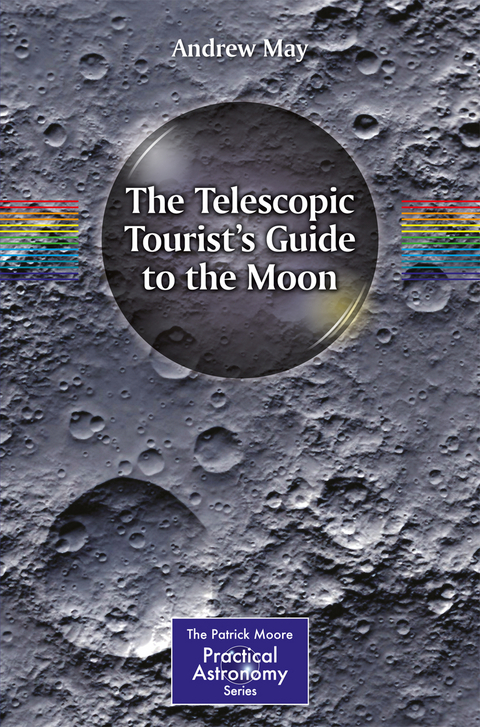
The Telescopic Tourist's Guide to the Moon
Springer International Publishing (Verlag)
978-3-319-60740-5 (ISBN)
Have you ever been inspired by stunning images from the Hubble telescope, or the magic of sci-fi special effects, only to look through a small backyard telescope at the disappointing white dot of a planet or faint blur of a galaxy? Yet the Moon is different. Seen through even a relatively cheap 'scope, it springs into life like a real place, with mountains and valleys and rugged craters. With a bit of imagination, you can even picture yourself as a sightseeing visitor there - which in a sense you are.
Andrew May got his first degree in Natural Sciences at Cambridge University (1979), then went on to gain a Ph.D. in astrophysics from Manchester University. He did 4 years postdoctoral research at the universities of Groningen (NL) and Oxford. After a few years working for various software companies, he joined the Civil Service in 1991, and spent the next 20 years doing defense-related scientific research. Since 2011, Andrew has done some part-time consultancy in the same field, as well as freelance writing. His books published to date include Bloody British History: Somerset (History Press, 2012), Conspiracy History (Bretwalda Books, 2014), Pocket Giants: Isaac Newton (History Press, 2015), Pocket Giants: Albert Einstein (History Press, 2016) and Pseudoscience and Science Fiction (Springer, 2016). His next book will be Destination Mars: The Story of our Quest to Conquer the Red Planet from Icon Books (expected summer 2017).
Chapter 1: Plan Your Trip.- Chapter 2: Essential Equipment.- Chapter 3: A Brief History of the Moon.- Chapter 4: Itinerary One - Around the Sea of Tranquility.- Chapter 5: Itinerary Two - The Far East.- Chapter 6: Itinerary Three - The Southern Highlands.- Chapter 7: Itinerary Four - Around the Sea of Clouds.- Chapter 8: Itinerary Five: The Imbrium Basin.- Chapter 9: Itinerary Six: The Ocean of Storms.- Chapter 10: Thematic Tours.- Chapter 11: The Dark Side of the Moon.- Chapter 12: Other Moons to Visit.- Chapter 13: Artificial Moons.- Chapter 14: The Future of Lunar Tourism.- Index.
"In the 1960s, Apollo astronauts were able to visit the Moon in person. Now readers can do the next best thing with this well illustrated and highly readable book about our nearest neighbor. ... The work should also find a home in the private library of any individual curious to learn more about the Moon. Summing Up: Highly recommended. Lower-division undergraduates and general readers." (C. G. Wood, Choice, Vol. 55 (8), April, 2018)
"For those whoare telescopically inclined, May takes us through choosing a telescope, photographic options ... and a various tours of aspects of the Moon's surface, from the great craters to sites of Apollo landings. ... for anyone beginning to explore the Moon with anything from binoculars to a heavy duty garden telescope, this is a brilliant introduction and guide." (Brian Clegg, Popular Science, popsciencebooks.blogspot.co.uk, July, 2017)
| Erscheinungsdatum | 18.07.2017 |
|---|---|
| Reihe/Serie | The Patrick Moore Practical Astronomy Series |
| Zusatzinfo | VII, 230 p. 120 illus., 78 illus. in color. |
| Verlagsort | Cham |
| Sprache | englisch |
| Maße | 155 x 235 mm |
| Gewicht | 440 g |
| Themenwelt | Sachbuch/Ratgeber ► Natur / Technik ► Weltraum / Astronomie |
| Naturwissenschaften ► Physik / Astronomie ► Angewandte Physik | |
| Naturwissenschaften ► Physik / Astronomie ► Astronomie / Astrophysik | |
| Technik ► Luft- / Raumfahrttechnik | |
| Schlagworte | astronautics • Astronomy, Observations and Techniques • Astronomy, space & time • Astronomy, space & time • Equipment to photograph the Moon • Finding craters on the Moon • Lunar geography • Lunar landing sites • Mountains on the Moon • Observing the Moon • Physics and Astronomy • Popular astronomy & space • Popular astronomy & space • Popular science • Popular Science in Astronomy • Science fiction set on the Moon • Space Sciences (including Extraterrestrial Physics • The Moon through a telescope |
| ISBN-10 | 3-319-60740-5 / 3319607405 |
| ISBN-13 | 978-3-319-60740-5 / 9783319607405 |
| Zustand | Neuware |
| Haben Sie eine Frage zum Produkt? |
aus dem Bereich


